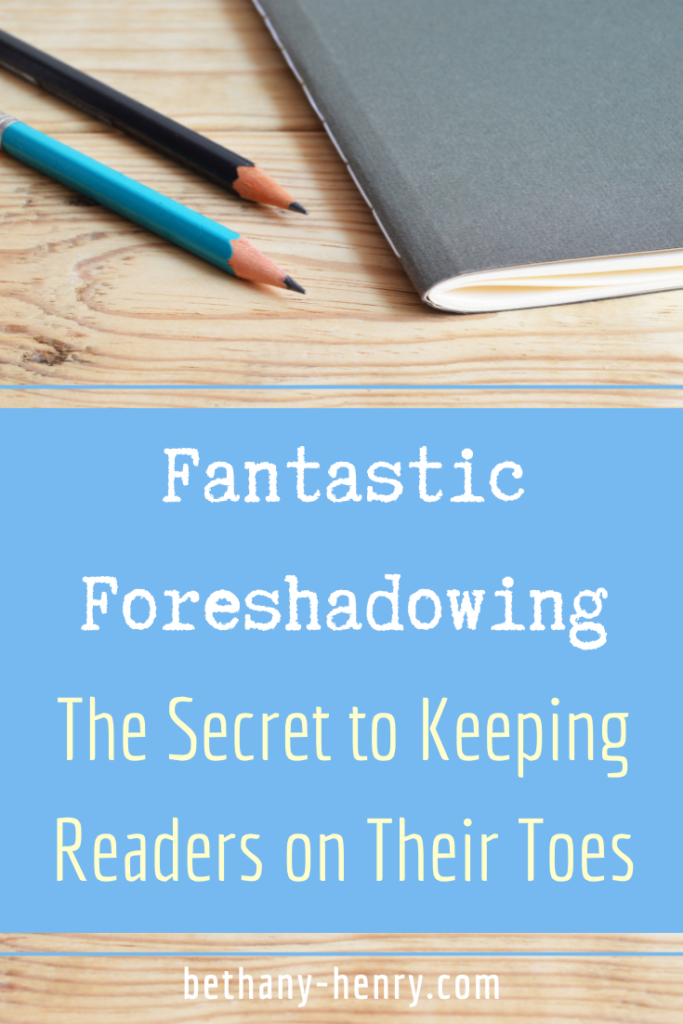
Today I am thrilled to have Lewis Jorstad here to share with us about foreshadowing in our stories!
Lewis is an author, editor, and the founder of The Novel Smithy, which is chock full off excellent resources for writers. You should check it out!
But first: foreshadowing. Take it away, Lewis!
Fantastic Foreshadowing
One of the best parts of being a writer is setting up interesting surprises throughout our novels. Not only are these surprises fun for us (who doesn’t love dangling a carrot for others to follow), but they’re also a blast for our readers. A great surprise completely shifts a reader’s understanding of our stories, creating a lasting impression that will stick with them long after our books reaches its end.
However, on their own, surprises aren’t always enough.
To reliably trigger these intense emotions, you want readers to have some sense that your big reveal is coming. By planting hints and clues throughout your novel, you give perceptive readers the satisfaction of saying “I knew it!”
How do you do this? Well, the secret is foreshadowing—and foreshadowing well. So, whether your hero is actually your villain’s son or your noble knight is about to face his downfall, here’s how foreshadowing fits in your writing arsenal!
Why Should You Care About Foreshadowing?
Foreshadowing is the act of hinting at future events early in your novel. These hints are never direct, but are instead subtle warnings to your readers that something big is on the horizon. When done well, this blends seamlessly into your story, so much so that many readers won’t consciously notice your hints—at least until they finally pay off!
Instead, foreshadowing is about creating suspense.
Though readers aren’t sure what’s next, they know something is coming. This makes foreshadowing a common literary device in thrillers, crime novels, and horror, though it has a place in every genre. You might foreshadow your hero’s secret identity as heir to the throne in a fantasy adventure, or foreshadow the true intelligence of your AI robots in a sci-fi novel. Whatever big reveal you’re building towards, this is a great way to create an intense “I knew it!” moment for your readers.
Beyond this basic use, foreshadowing also affects your novel in a few other ways:
- Setting the Tone: Foreshadowing is great for creating a moody, uncertain, or even curious tone in your story. In many genres, this is used to lend the story a dark and stormy vibe.
- Writing a Page-Turner: If readers can tell something big is about to happen, they’ll be on the edge of their seats waiting for the other shoe to drop. Because of this, foreshadowing is often a big part of writing a page-turner.
- Supercharging Your Pacing: Foreshadowing is an excellent tool for ramping up your pacing before your novel’s finale. As more and more clues appear, readers will be anxious to know how your novel ends. Combine this with a well-written Climax and you have a great recipe for an intense finish!
- Creating Catharsis: Finally, foreshadowing is key to creating catharsis. Catharsis is the feeling of emotional satisfaction readers get at the end of a good novel, and it’s our goals as writers to give them that satisfaction. By foreshadowing major events, you build up emotional tension that you can then release when the time is right—thus triggering catharsis.
Of course, this requires a careful balancing act.
On the one hand, foreshadowing is awesome, and an important tool for writing an intriguing story! However, it’s also easy to overdo. Many writers share too much, thus spoiling the surprise too early, or try to make every part of their novel into some mysterious reveal.
Fortunately, walking that line is tricky, but not impossible. The key is understanding the different types of foreshadowing, as well as how to put those types into practice in your own novels.
3 Types of Powerful Foreshadowing
Foreshadowing Through Clues:
The most common (and easiest) type of foreshadowing is where you drop subtle clues that allude to some later event, but that don’t reveal the full story. These could include anything from a sly piece of dialog, to your protagonist noticing someone else’s shoes at their neighbor’s front door.
Whatever this clue is, it should usually be nondescript. Perceptive readers will notice something is off, but most will only get the subconscious feeling that things are changing—even if they can’t put their finger on what that change is.
A great example of this style of foreshadowing comes from The Wizard of Oz.
At the start of the film, we’re introduced to a variety of characters with peculiar quirks and habits. Later, we meet similar characters in Oz that seem suspiciously familiar. And finally, we realize that Dorothy’s time searching for the wizard was really all a dream. The characters in Oz were just her mind’s interpretation of the real people back home—foreshadowing the true nature of the strange world she finds herself in.
Foreshadowing Through Symbolism:
Next up, symbolism is a fantastic tool for foreshadowing, encompassing everything from prophecies to dreams and physical objects. These symbols are often more direct, making them a great way to build suspense before a big reveal.
In fact, this style of foreshadowing is closely related to another writing technique: Chekov’s Gun. If you’re not familiar with Chekov’s Gun, it’s the idea that every element of your novel should pay off before your story is through. If you place a gun on the table in Act One, it better go off by Act Three.
So, how does this affect foreshadowing?
Well, most readers pay careful attention to the symbols you introduce throughout your story, even if only subconsciously. Because of this, these symbols are ripe for foreshadowing. By placing that gun on the table, readers are now on the lookout for it to appear again. When it does, it means something is about to happen, building up to some later reveal.
Of course, this comes with an important warning: You must pay off your symbolism. This is a core tenant of Chekov’s Gun, and for good reason. If you foreshadow a symbol throughout your story, readers will be very disappointed if that symbol never amounts to anything by the end.
Foreshadowing Through Mirror Moments:
Finally, one of the more unique forms of foreshadowing are mirror moments.
A mirror moment is a scene late in your novel that “mirrors” or calls back to an earlier scene, drawing readers’ attention to the parallels between both events. This is a classic form of foreshadowing in horror or post-apocalyptic stories in particular. Early in your story, your protagonist might introduce their childhood home, only to stumble upon an eerily similar—but abandoned—location later in your novel. In doing so, they foreshadow the true nature of your story, helping readers connect the dots about what’s happened to their world.
When used well, this is a great tool for building suspense. As readers recognize similar situations, settings, and events, they’ll remember your prior scene and be primed for what’s coming next.

How to Foreshadow (And Foreshadow Well)
Now that you understand the various types of foreshadowing, it’s time to apply them to your story. As I mentioned earlier, this isn’t always intuitive. Our instinct is often to overshare, spoiling many of the best secrets in our novels. If we want our foreshadowing to go well, it needs to be subtle—but, it also can’t be invisible.
To help you out, here are a few tips for foreshadowing done right:
- Keep Your Promises: No matter what you’re trying to foreshadow, you must pay it off before your novel ends. Think of your story as a pact with your reader. If you promise a symbol or clue holds some importance or greater meaning, you need to keep that promise.
- Trust Your Readers: Just like you need to keep your promises, you also need to trust your readers. Don’t shove your foreshadowing in their face! Instead, allow them to notice (or not notice) any hints organically, so that your final reveal feels like something they’ve earned.
- Start Early: Foreshadowing works best when you plant hints early in your novel. This gives them time to develop throughout your story, so that their eventual payoff feels impactful. If possible, try to begin foreshadowing major events within Act One, if not early in Act Two.
- Pick and Choose: Though foreshadowing is a fantastic tool, not every surprise in your novel needs to be foreshadowed ahead of time. Instead, save foreshadowing for one or two major reveals, especially if you want those reveals to stand out to your readers.
- Have a Plan: Having a plan before you begin writing is key to effective foreshadowing. To do this, create a story outline that includes the key event you want to foreshadow, what symbol, clue, or mirror moment you’ll use, and how it will appear throughout your story.
- Save It for Later: Finally, if you’re still working on your first draft, don’t worry about foreshadowing. At this point, most writers are still expanding their story, meaning a lot is in flux. Instead, wait to place any hints or clues in your second or third draft, once you have a better handle on your novel.
Looking for some examples of great foreshadowing? Here are a few of my favorites:
- The Empire Strikes Back: Luke sees a vision of his face beneath Darth Vader’s mask while training with Yoda. This foreshadows both his relationship to Vader, and the moment he removes Vader’s mask to see his father’s face for the first time later in the trilogy.
- The Prestige: A young boy cries when a bird is crushed as part of a magic trick. His mother tries to comfort him, but the boy insists the bird is dead and that his brother is being used in his place. This foreshadows the big reveal that Borden is an identical twin, with all of his tricks relying on his brother sharing his identity.
- Macbeth: The three witches directly foreshadow Macbeth’s downfall through a prophecy. They tell him he’ll eventually become king, but also warn his friend Banquo that his sons will inherit the throne next—thus threatening Macbeth’s future.
And with that, you’re ready to begin!
Now that you understand the types of foreshadowing you might use, your next step is to decide what you want to foreshadow in the first place. What is your novel’s big reveal? What (subtle) hints could you leave to clue readers in to what’s coming?
No matter what your story is about, some careful foreshadowing will go a long way in keeping readers on their toes!

Lewis Jorstad is an author and developmental editor who helps up-and-coming writers hone their writing craft over at The Novel Smithy. When he isn’t working on the next book in his Writer’s Craft series, you can find him playing old Gameboy games and sailing somewhere around the eastern half of the US. You can also check out his free story bible template, and grab a copy for yourself!


